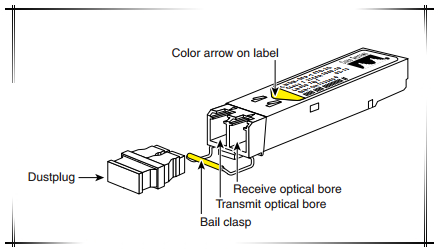- Related articles
- Optical Transceivers for Cisco WS-C2960S-F24TS-S Switch
- The difference between SFP and SFP+, XFP, QSFP, GBIC, BIDI
- Optical Transceivers for Cisco WS-C3560-48PS-S Switch
- Optical Transceivers for Cisco WS-C2960X-48LPD-L Switch
- Optical Transceivers for Cisco SF350-48-K9-EU Switch
- The Difference between Fast Ethernet Card and Gigabit Ethernet Card
- Optical Transceivers for Cisco IE-2000-8TC-G-E Switch
- Buy Cisco GLC-SX-MM SFP For Fiber Optic Networks
- What is 10GBASE-T transceiver?
- The Uses of PCI Express x1

Definition:
The small form-factor pluggable (SFP) is a compact, hot-pluggable transceiver used for both telecommunication and data communications applications. The form factor and electrical interface are specified by a multi-source agreement (MSA) under the auspices of the SFF Committee. It interfaces a network device motherboard (for a switch, router, media converter or similar device) to a fiber optic or copper networking cable. It is a popular industry format jointly developed and supported by many network component vendors. SFP transceivers are designed to support SONET, gigabit Ethernet, Fibre Channel, and other communications standards. Due to its smaller size, SFP obsolesces the formerly ubiquitous gigabit interface converter (GBIC); the SFP is sometimes referred to as a Mini-GBIC. In fact, no device with this name has ever been defined in the MSAs.
What is SFP in Networking Switches?
SFP stands for "small form-factor pluggable" and is a hot-swappable input/output device that plugs into a Gigabit Ethernet port or slot, linking the port with the network. SFPs can be used and interchanged on a wide variety of products and can be interchanged in combinations of 1000BASE-SX, 1000BASE-LX/LH, 1000BASE-ZX, or 1000BASE-BX10-D/U on a port-by-port basis. You can use them for Gigabit Ethernet or Fibre Channel applications. They provide a flexible and cost-effective solution for enterprise networks, data centers, etc.
SFP in Storage
New dynamics within data centers mandate that the cable infrastructure handles latency sensitive applications anywhere. When comparing 10GBase-T technology with the alternative SFP technology, it is evident that SFP is the right technology to ensure optimal performance with lowest latency in the data center. SFP technology delivers far lower power usage than the 10GBase-T technology. The cost saving becomes obvious when deploying from 1000 to 10,000 cables in the data center.
Conclusion:
SFP transceivers are compatible with a number of communication standards like Ethernet, SONET along with many other standards. SFP is an upgraded version of Giga Bit Interface Converter (GBIC) module. SFP uses LC fiber optic cable for its interface whereas SC cable interfaces are used in GBIC. SFP is more space saving than GBIC, since the former has only half the size of the latter. SFP has transmission rate ranging from 100Mbps to 4Gbps and it can work at distances ranging between 500 meters to hundreds of kilometers. The ‘hot-pluggable’ feature of SFP makes it flexible. Any future changes can be easily incorporated into the SFP module, while the maintenance of the module is also made easier by this hot-pluggable nature of SFP, thereby making it compact.
Please click to check more related concepts:
| Transceivers Package | Ethernet standard | Application | Transceivers Wavelength | Fiber mode | Interface |
| SFP+ | 100Base-FX | Bidi | |||
| XFP | 1000Base-X | DWDM | Multi-mode | ||
| QSFP+ | 1000BASE-T | WDM | |||
| X2 | 10GBASE-SR | ||||
| GBIC | 10GBASE-T | ||||
| CFP | |||||
| CSFP |






















































